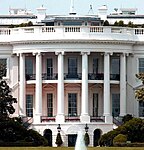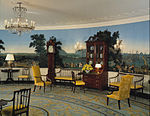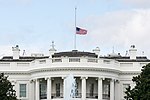Blue Room (White House)
Rooms in the White House

The Blue Room is one of three state parlors on the first floor in the White House, the residence of the president of the United States. It is distinct for its oval shape. The room is used for receptions and receiving lines and is occasionally set for small dinners. President Grover Cleveland married Frances Folsom in the room on June 2, 1886, the only wedding of a President and First Lady in the White House. The room is traditionally decorated in shades of blue. With the Yellow Oval Room above it and the Diplomatic Reception Room below it, the Blue Room is one of three oval rooms in James Hoban's original design for the White House.
Excerpt from the Wikipedia article Blue Room (White House) (License: CC BY-SA 3.0, Authors, Images).Blue Room (White House)
Pennsylvania Avenue Northwest, Washington
Geographical coordinates (GPS) Address Website Nearby Places Show on map
Geographical coordinates (GPS)
| Latitude | Longitude |
|---|---|
| N 38.8975 ° | E -77.0365 ° |
Address
White House
Pennsylvania Avenue Northwest 1600
20500 Washington
District of Columbia, United States
Open on Google Maps











